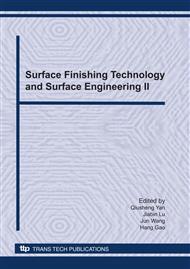p.220
p.226
p.232
p.238
p.243
p.249
p.255
p.260
p.265
Investigation of Surface Roughness during Turning Process Based on Response Surface Methodology
Abstract:
The purpose of this study was to analyze the effects of cutting parameters on the surface roughness (Ra) when turning of alloy cast iron using uncoated carbide insert under dry cutting condition. The mathematical model for the surface roughness was developed by response surface methodology (RSM).Response surface contours were constructed and used for determining the optimum cutting conditions to reduce machining time without increasing the surface roughness.
Info:
Periodical:
Pages:
243-248
Citation:
Online since:
October 2010
Authors:
Price:
Сopyright:
© 2010 Trans Tech Publications Ltd. All Rights Reserved
Share:
Citation:


